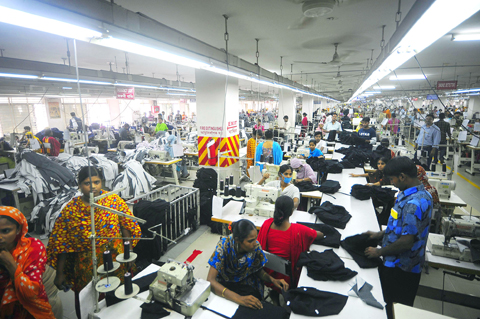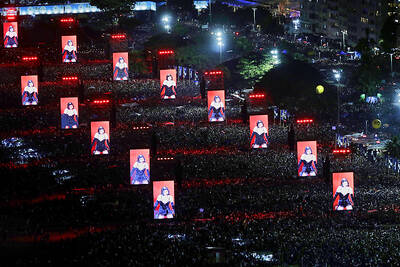Global retailers fleeing China’s rising labor costs now find themselves facing growing pressure for higher wages in countries from Bangladesh to Cambodia, Vietnam, India and Indonesia.
The latest sign that workers are becoming more militant in their demands for a larger share of the region’s economic success came in Cambodia last week, when tens of thousands of workers went on strike.
The mass protest rejecting a proposed 20 percent pay increase crippled export-orientated garment industry, which produces items for renowned brands including Gap, Benetton, Adidas and Puma.

PHOTO: AFP
The strike followed a deal between the government and industry that set the minimum wage for garment and footwear staff at US$61 a month. Unions want a base salary of US$93.
“Workers are having difficulties surviving on their low wages,” said Kong Athit, secretary general of the Cambodian Labour Confederation.
The Cambodian action came just weeks after Bangladesh’s 3 million garment workers, who make Western clothes for the world’s lowest industrial wages, spurned an 80 percent pay hike, attacking factories and burning cars.

PHOTO: AFP
Tens of thousands of workers who sew clothes for brands such as H&M and Tesco went on the rampage over the 3,000 taka (US$43) monthly minimum wage offer, then staged wildcat strikes protesting a four-month delay in implementation.
“It is not a living wage,” said Shahidul Islam Sabug of the Garment Workers Unity Forum, which wanted 5,000 taka a month to help workers cope with sharp increases in the cost of living, including near double-digit food inflation.
Earlier this month, Bangladesh said exports leapt more than 25 percent year on year in July, with manufacturers linking the jump to a shift in orders from China.
In China itself, workers scored major victories this year at companies such as Japanese automakers Honda and Toyota and Taiwanese information-technology giant Foxconn, which were all forced to hike pay in the so-called “workshop of the world.”
In an effort to ease worker concerns, most Chinese provinces, regions and municipalities have raised official minimum wages this year, with Shanghai atop the list, offering monthly pay of at least 1,120 yuan (US$166).
“Costs are going up in places like China, so you are getting a move to Vietnam, Cambodia, Bangladesh and this is good for these countries,” said Robert Broadfoot of the Hong Kong-based Political and Economic Risk Consultancy.
And even if manufacturers are now facing wage pressures in the new manufacturing centers, they are on a different scale.
“China is getting more expensive. To be sure, less developed countries are too, but the gap between per capita incomes in places like Bangladesh, Cambodia and Vietnam and those in China will continue to widen going forward,” Broadfoot said.
“Wages of workers in these countries are unlikely to go up in absolute terms step for step with China’s wages,” he said.
In Cambodia, union leaders called off the strike last Thursday after the government stepped in and arranged talks with both manufacturers and unions for later this month.
Cambodia’s garment industry is a key source of foreign income for the country and employs about 345,000 workers.
Cambodian Social Affairs Minister It Samheng warned that further stoppages could “affect benefits for the workers, employers, and our nation that is facing the impact of the global financial crisis.”
Bangladesh’s protests, which raged for days until a massive police crackdown restored calm, were the most violent of a string of recent strikes in Asian countries.
In Vietnam, where independent trade unions are banned and inflation is running at some 8.75 percent there have been 139 strikes in the first five months of this year, the Vietnam Confederation of Labour said.
The bulk of the protests concern low pay and poor conditions, with many of them hitting foreign-owned factories. Tens of thousands of workers at a Taiwanese-owned shoe factory in southern Vietnam went on strike in April.
In Indonesia, where three powerful trade unions represent the vast majority of the country’s 3.4 million unionized workers, there is also mounting pressure to raise the minimum wage.
Garment factories in particular, including some that are foreign-owned, have been hit by strikes and disputes over long hours and low wages.
The minimum wage is not set in Jakarta and varies from district to district. In 2008 the highest minimum wage was US$123 a month in Papua province and the lowest US$60 in East Java, according to the manpower ministry.
Tens of thousands of workers protested for minimum wage levels to be raised during May Day demonstrations in Jakarta this year, until riot police stepped in to quell the unrest.
India, which has a highly vocal workers’ movement, has also seen recent disputes over pay and conditions at companies such as mobile handset manufacturer Nokia, car maker Hyundai and the technology and services group Bosch.

Kehinde Sanni spends his days smoothing out dents and repainting scratched bumpers in a modest autobody shop in Lagos. He has never left Nigeria, yet he speaks glowingly of Burkina Faso military leader Ibrahim Traore. “Nigeria needs someone like Ibrahim Traore of Burkina Faso. He is doing well for his country,” Sanni said. His admiration is shaped by a steady stream of viral videos, memes and social media posts — many misleading or outright false — portraying Traore as a fearless reformer who defied Western powers and reclaimed his country’s dignity. The Burkinabe strongman swept into power following a coup in September 2022

‘FRAGMENTING’: British politics have for a long time been dominated by the Labor Party and the Tories, but polls suggest that Reform now poses a significant challenge Hard-right upstarts Reform UK snatched a parliamentary seat from British Prime Minister Keir Starmer’s Labor Party yesterday in local elections that dealt a blow to the UK’s two establishment parties. Reform, led by anti-immigrant firebrand Nigel Farage, won the by-election in Runcorn and Helsby in northwest England by just six votes, as it picked up gains in other localities, including one mayoralty. The group’s strong showing continues momentum it built up at last year’s general election and appears to confirm a trend that the UK is entering an era of multi-party politics. “For the movement, for the party it’s a very, very big

ENTERTAINMENT: Rio officials have a history of organizing massive concerts on Copacabana Beach, with Madonna’s show drawing about 1.6 million fans last year Lady Gaga on Saturday night gave a free concert in front of 2 million fans who poured onto Copacabana Beach in Rio de Janeiro for the biggest show of her career. “Tonight, we’re making history... Thank you for making history with me,” Lady Gaga told a screaming crowd. The Mother Monster, as she is known, started the show at about 10:10pm local time with her 2011 song Bloody Mary. Cries of joy rose from the tightly packed fans who sang and danced shoulder-to-shoulder on the vast stretch of sand. Concert organizers said 2.1 million people attended the show. Lady Gaga

SUPPORT: The Australian prime minister promised to back Kyiv against Russia’s invasion, saying: ‘That’s my government’s position. It was yesterday. It still is’ Left-leaning Australian Prime Minister Anthony Albanese yesterday basked in his landslide election win, promising a “disciplined, orderly” government to confront cost-of-living pain and tariff turmoil. People clapped as the 62-year-old and his fiancee, Jodie Haydon, who visited his old inner Sydney haunt, Cafe Italia, surrounded by a crowd of jostling photographers and journalists. Albanese’s Labor Party is on course to win at least 83 seats in the 150-member parliament, partial results showed. Opposition leader Peter Dutton’s conservative Liberal-National coalition had just 38 seats, and other parties 12. Another 17 seats were still in doubt. “We will be a disciplined, orderly